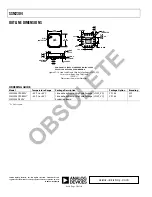
SSM2304
Rev. 0 | Page 18 of 20
GETTING STARTED
To ensure proper operation, follow these steps:
1.
Verify that the control switches are at the proper positions.
2.
Put S1H, the shutdown control, in the lower position to
turn on the amplifier.
3.
Put S1G, the gain selection, in the upper position for
higher gain and in the lower position for lower gain.
4.
Connect the power supply with the right polarity and
proper voltage.
5.
Connect the loads to the proper output ports. Depending
on the application, use nodes OUTBL+, OUTBL−, OUTBR+,
and OUTBR− to connect the loads after the beads or use
nodes OUTLL+, OUTLL−, OUTLR+, and OUTLR− to
connect the loads after the inductors.
WHAT TO TEST
1.
EMI (electromagnetic interference). Connect wires for the
speakers that are the length required for the application
and perform the EMI test.
2.
Signal-to-noise ratio.
3.
Output noise. Use an A-weighting filter to filter the output
before the measurement meter.
4.
Maximum output power.
5.
Efficiency.
6.
Component selections.
Selecting the correct components is the key for achieving the
performance required at the cost budgeted.
1.
Input coupling capacitor selection. Capacitors C1, C2, C3,
and C4 should be large enough to couple the low frequency
signal components in the incoming signal, but small enough
to filter out unnecessary low frequency signals. For music
signals, the cutoff frequency is often chosen between 20 Hz
and 30 Hz. The cutoff frequency is calculated by
C
= 1/(2
Rfc
)
where
R
is 150k, and
fc
is the cutoff frequency.
2.
Input serial resistors (R1, R2, R3, and R4). These resistors
are not necessary for the amplifier to operate and are only
needed when special gain values are required. Using
resistors of too high a value increases the input noise.
3.
Output beads (B1, B2, B3, and B4). The output beads are
necessary components for filtering out the EMIs caused at
the switching output nodes. Ensure that these beads have
enough current conducting capability while providing
sufficient EMI attenuation. The current rating needed for
an 8 Ω load is about 600 mA, and the impedance for
100 MHz must be greater than 600 Ω. In addition, the
lower the DCR (dc resistance) of these beads, the better for
minimizing their power consumptions. The recommended
bead is described in Table 6.
4.
Output shunting capacitors for the beads. There are two
groups of these capacitors: C11, C12, C13, and C14 and
C23, C24, C25, and C26. The former is for filtering out the
lower frequency EMIs (those up to 250 MHz), and the latter
is for filtering out the higher frequency EMIs (those greater
than 250 MHz). Use small size (0603 or 0402) multilayer
ceramic capacitors of a X7R or COG (NPO) material. The
higher the value of these capacitors, the lower the residual
EMI level at the output and the higher the quiescent current
at the power supply. It is recommend to use 500 pF to 1 nF
values for the first group of capacitors and 100 pF to 200 pF
for the second group of capacitors.
5.
Output inductors. Some users do not allow high frequency
EMIs in the system and prefer using inductors to filter the
output of the high frequency components at the output nodes.
Choose an inductance greater than 2.2 μH for these inductors.
The higher the inductance, the lower the EMI at the output
and the lower the quiescent current at the power supply.
However, higher inductance also corresponds with higher
power consumption by the inductors when the output power
level is high. It is recommended to use 2.2 μH to 10 μH
inductors; the current rating must be greater than 600 mA
(saturation current) for an 8 Ω load. Table 7 describes the
recommended inductors.
Table 6.
Part No.
Manufacturer
Z (Ω)
I
MAX
(mA)
DCR (Ω)
Size (mm)
MPZ1608S601A
TDK
600
1000
0.15
1.6 × 0.8 × 0.8
Table 7.
Part No.
Manufacturer
L (μH)
I
MAX
(mA)
DCR (Ω)
Size (mm)
LQH32CN4R7M53
Murata Manufacturing Co., Ltd.
4.7
650
0.15
3.2 × 2.5 × 1.55
LQH32CN3R3M53
Murata Manufacturing Co., Ltd.
3.3
710
0.12
3.2 × 2.5 × 1.55
LQH32CN2R2M53
Murata Manufacturing Co., Ltd.
2.2
790
0.1
3.2 × 2.5 × 1.55
SD3118-100-R
Cooper Bussmann, Inc.
10
900
0.3
3.1 × 3.1 × 1.8
ELL4LM100M
Panasonic Corporation
10
690
0.18
3.8 × 3.8 × 1.8
LBC2518T2R2M
Taiyo Yuden Co., Ltd.
2.2
630
0.13
2.5 × 1.8 × 2
1033AS-4R7M
Toko Inc.
4.7
680
0.31
3.8 × 3.8 × 1
OBSOLETE

















